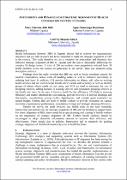| dc.contributor.author | Odit Adie, Mary C | |
| dc.contributor.author | Semwanga Rwashana, Agnes | |
| dc.contributor.author | Mayoka Kituyi, Geoffrey | |
| dc.date.accessioned | 2018-08-24T06:20:29Z | |
| dc.date.available | 2018-08-24T06:20:29Z | |
| dc.date.issued | 2014-06-01 | |
| dc.identifier.citation | Odit,M.C.A.,Semwanga,R.A.,Mayoka,K.G.(2014).Antecedents and dynamics for strategic alignment of health information systems in Uganda,64, (6), 1-20.0 | en_US |
| dc.identifier.uri | http://hdl.handle.net/20.500.12282/3077 | |
| dc.description | Its an article | en_US |
| dc.description.abstract | Health Information Systems (HIS) in Uganda always fail to achieve the organizational
objectives and yet little research has been conducted to study the strategic alignment of HIS
in the country. This study therefore set out to examine the antecedents and dynamics that
influence strategic alignment of HIS in Uganda with the aim of adequately addressing the
complex IS design issues. A total of 296 respondents were purposively selected from 39
health facilities across the country to participate in the survey. Data was analyzed using
descriptive statistics.
Findings from the study revealed that HIS are used to locate substitute sources for
medical commodities, reduce costs of handling orders as well as minimize uncertainty in
ordering lead time. In addition, HIS provide information to clients, add value to existing
health services and are used to target health service needs with accuracy as well as identify
groups of clients whose needs are not being met. HIS are used to minimize the cost of
designing services, adding features to existing services and population grouping services at
the health unit level. In the area of internal health facility efficiency, HIS help in ensuring
efficiency and enable informed decision making, provide efficiency in internal meetings and
discussions, co-ordination among facility departments, and provide good evaluation on
annual budget. Further, HIS are used by health workers to provide evaluation on capital,
maximize organizational performance, population coverage and strategic planning efficiency.
Despite the above, the study revealed that health units do not have standards,
frameworks and policies for the strategic alignment of HIS and the funding to support them.
For better alignment of HIS, there should be proper planning and training of health workers
on the importance of strategic alignment of HIS. Further, health facilities should be
encouraged to adopt electronic information systems to improve their efficiency and
effectiveness. There should also be policies, frameworks and or standards for guiding
strategic alignment of Health Information Systems in health facilities. | en_US |
| dc.description.sponsorship | Makerere University Business | en_US |
| dc.language.iso | en | en_US |
| dc.subject | Information | en_US |
| dc.subject | Systems | en_US |
| dc.subject | strategic | en_US |
| dc.subject | analyzed | en_US |
| dc.title | Antecedents and dynamics for strategic alignment of health information systems in Uganda | en_US |
| dc.type | Article | en_US |

